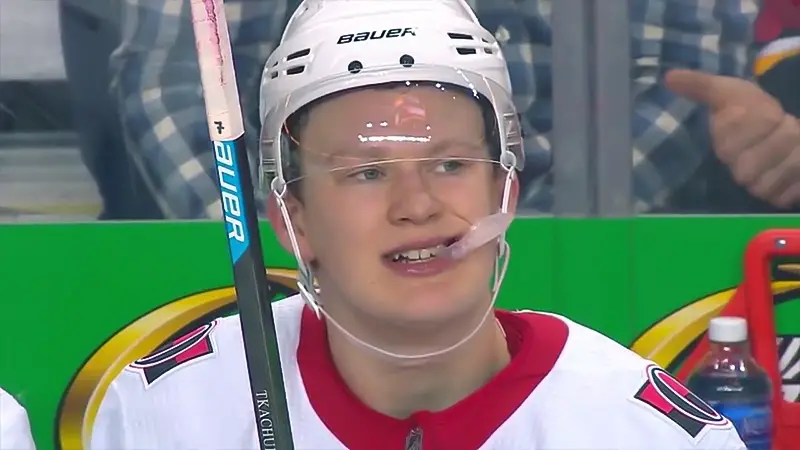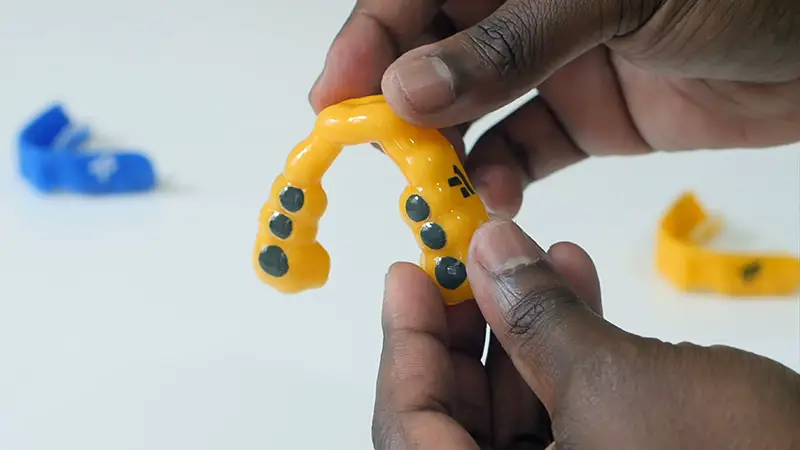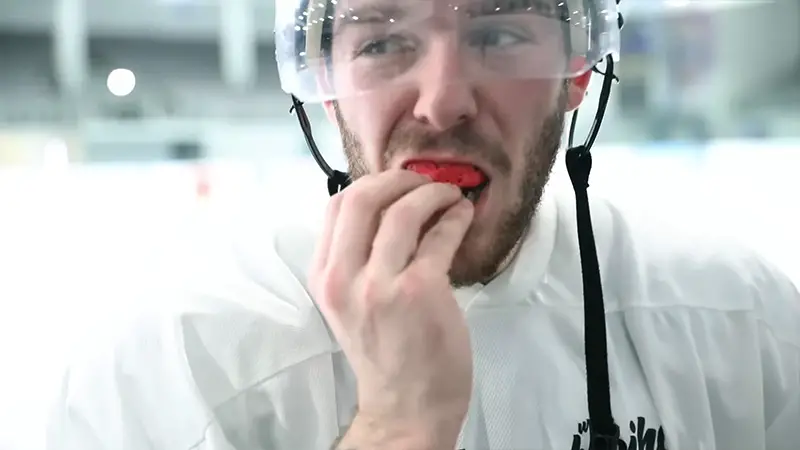Hockey, known for its ferocious pace and high-impact nature, is a sport that demands intense physicality and unwavering focus.
Yet, if you observe closely, you’ll notice that not all hockey players choose to wear mouthguards, a piece of protective gear seemingly essential for a sport where pucks fly at astonishing speeds and collisions are commonplace.
This blog post delves into the intriguing world of hockey and the reasons behind why don’t hockey players wear mouthguards.
From comfort concerns and traditional norms to the psychology behind personal preferences, we’ll explore the multifaceted aspects that shape a hockey player’s decision regarding mouthguards.
We’ll also touch upon the regulations within professional leagues like the NHL and how they influence players’ choices. Stay focused.

What Are the Mouthguards That Players Wear?
The mouthguards that players wear, often referred to as sports mouthguards or simply mouthguards, are protective devices designed to safeguard the teeth, gums, and surrounding oral structures during sports or physical activities.
Purpose of Mouthguards
- Mouthguards serve as protective devices designed to safeguard the oral structures of athletes during physical activities.
- They are a crucial element of sports equipment, aiming to prevent injuries to the teeth, gums, and surrounding structures in the mouth.
Materials
- Mouthguards are typically constructed from pliable materials such as silicone or thermoplastic.
- These materials are chosen for their flexibility, durability, and shock-absorbing properties, which help absorb and disperse impact forces effectively.
Custom-Fit vs. Over-the-Counter
- Custom-fitted mouthguards are individually molded by dental professionals to precisely fit a player’s teeth and mouth.
- Over-the-counter options are more readily available and can be adapted to fit using a process called “boil-and-bite,” where they are softened in hot water, and then bitten into for a semi-custom fit.
Dental Protection
- The primary function of mouthguards is to protect teeth from injuries during sports activities.
- They act as a barrier, reducing the risk of teeth chipping, breaking, or being completely knocked out in cases of impact.
Soft Tissue Protection
- Mouthguards also serve as a cushioning barrier, reducing the risk of soft tissue injuries.
- They minimize the chances of cuts, bruises, and lacerations to the lips, tongue, and cheeks when accidental contact or collisions occur.
Concussion Mitigation
- While not their primary function, some studies suggest that mouthguards may help reduce the severity and frequency of concussions.
- They absorb and distribute impact forces, potentially lessening the impact on the head and brain during collisions.
Compliance in Sports
- Many sports governing bodies, including those for hockey, football, rugby, and martial arts, mandate the use of mouthguards.
- These regulations aim to ensure player safety and minimize dental injuries by making mouthguard use a requirement.
Customization
- Custom-fitted mouthguards offer a higher level of protection and comfort.
- They are preferred by professional athletes who prioritize safety and performance because they are specifically tailored to fit their unique mouth and dental structure.
Maintenance
- Proper care and cleaning of mouthguards are essential to prolong their lifespan and maintain hygiene.
- Regular cleaning, storage in a protective case, and periodic examination for wear and tear are key practices for ensuring effective and safe use.
Should Hockey Players Wear Mouthguards?
Yes, hockey players should absolutely wear mouthguards. Mouthguards are essential protective gear for hockey players, just as they are for athletes in many other sports.
There are several reasons why hockey players should wear mouthguards:
Dental Protection
Hockey is a high-impact sport with the potential for collisions, sticks, pucks, and falls. A mouthguard helps protect the teeth from getting chipped, broken or knocked out during such incidents.
Preventing Soft Tissue Injuries
Mouthguards also protect the soft tissues in the mouth, such as the lips, tongue, and cheeks, reducing the risk of cuts, bruises, and lacerations.
Concussion Prevention
While not a guarantee, some studies suggest that properly fitted mouthguards may help reduce the risk and severity of concussions by absorbing and dissipating some of the force from impacts to the head.
Compliance with Rules
In many hockey leagues, wearing a mouthguard is a mandatory requirement, and players may face penalties or suspensions if they do not comply.
Wearing a mouthguard is a simple yet effective way for hockey players to protect their oral health and reduce the risk of serious injuries while on the ice.
Why Don’t Hockey Players Wear Mouthguards?
While it is highly recommended and often mandatory for hockey players to wear mouthguards, some players may choose not to wear them for various reasons.
Here are a few reasons why some hockey players might opt not to wear mouthguards:
Comfort and Fit Issues
Ill-fitting or uncomfortable mouthguards can be distracting and affect a player’s ability to breathe and communicate on the ice.
Some players may find it challenging to get used to wearing a mouthguard that doesn’t fit well.
Tradition and Culture
In some cases, there may be a cultural or historical tradition within a team or league that discourages or does not emphasize the use of mouthguards.
Players may be influenced by the attitudes and practices of their peers and predecessors.
Lack of Awareness
Some players, particularly at lower levels of play, may not fully understand the importance of mouthguards for their safety. They may underestimate the risks of dental and facial injuries in hockey.
Inconvenience
Mouthguards require proper maintenance, cleaning, and replacement when they become worn or damaged. Some players may find these responsibilities inconvenient and may not prioritize them.
Personal Preferences
Wearing a mouthguard is a personal choice for athletes. Some players may believe that the benefits do not outweigh the drawbacks, or they may not perceive themselves to be at a high risk of injury.
Rules Regarding Wearing Mouthguards in NHL

In terms of mouthguards, the NHL does not explicitly mandate that players wear them, but it strongly recommends their use.
Many NHL players choose to wear custom-fitted mouthguards for protection, as dental injuries are a known risk in the sport.
Here are some key points regarding the rules and regulations related to wearing mouthguards in the NHL:
Recommendation, Not Requirement
The NHL strongly recommends that players wear mouthguards for dental protection, but it is not a strict requirement in the league’s official rules.
Custom-Fitted Mouthguards
Many NHL players choose to wear custom-fitted mouthguards to ensure a comfortable and secure fit. These mouthguards provide better protection and are less obstructive than generic options.
Visors Are Encouraged
While full-face cages are not allowed in the NHL, visors are strongly encouraged, especially for players entering the league. Visors offer eye protection and may provide some facial coverage.
Exemptions for Veteran Players
Some veteran NHL players who entered the league before the introduction of visor requirements are exempt from wearing visors.
However, they still have the option to wear them if they choose to do so.
Safety Emphasis
The NHL’s stance on mouthguards and visors reflects its commitment to player safety, aiming to reduce the risk of dental and facial injuries while allowing players some degree of choice and comfort regarding their equipment.
The Impact of Not Wearing Mouthguards in Sports

Not wearing mouthguards in sports can have significant and potentially serious consequences for athletes. Here are some of the impacts of not wearing mouthguards in sports:
Dental Injuries
The most immediate and common impact is an increased risk of dental injuries. Sports-related accidents, collisions, and impacts can result in broken, chipped, or knocked-out teeth.
Mouthguards provide a protective barrier that helps absorb and distribute the force of these impacts, reducing the likelihood of dental trauma.
Soft Tissue Injuries
Without mouthguards, athletes are also more susceptible to soft tissue injuries in the mouth.
This can include cuts, lacerations, and bruising to the lips, tongue, and cheeks. Mouthguards act as a cushion and provide a barrier that minimizes the risk of these injuries.
Financial Costs
Dental injuries resulting from not wearing mouthguards can be expensive to treat. Restorative dental work, such as fillings, crowns, or dental implants, can be necessary to repair damaged teeth.
These costs can add up, and in some cases, insurance may not cover the full expense.
Pain and Discomfort
Dental injuries can be painful and uncomfortable. They may require immediate attention and can lead to ongoing discomfort until the issue is resolved.
Psychological Impact
Dental injuries can also have a psychological impact on athletes, affecting their self-esteem and confidence, especially if the injuries result in noticeable changes to their smiles.
Risk of Concussions
While not directly related to mouthguards, dental injuries can indirectly increase the risk of concussions.
Impact forces that might have been partially absorbed by a mouthguard can instead be transmitted to the head, potentially leading to head injuries.
Impact on Performance
The fear of potential dental injuries can affect an athlete’s performance and concentration.
Knowing they are protected by a mouthguard can boost an athlete’s confidence and allow them to focus on the game.
Not wearing mouthguards in sports can lead to a range of negative consequences, from dental and soft tissue injuries to financial costs and psychological impacts.
FAQs
Why don’t all hockey players wear mouthguards?
While strongly recommended, not all players wear mouthguards due to comfort issues, personal preferences, or a lack of awareness about the risks.
However, many professional and organized amateur leagues encourage their use to reduce dental injuries.
Do NHL players wear mouthguards?
NHL players are not required to wear mouthguards, but many choose to wear custom-fitted ones for dental protection. The league emphasizes visors for eye protection instead of full-face cages or shields.
Are there penalties for not wearing a mouthguard in hockey?
In most cases, there are no specific penalties for not wearing a mouthguard in hockey. However, not wearing a visor when required can result in penalties or fines in the NHL.
Do mouthguards affect communication on the ice?
Well-fitted mouthguards should not significantly hinder communication on the ice. Custom-fitted ones are more comfortable and allow for clear speech while providing dental protection.
Can mouthguards prevent concussions in hockey?
Mouthguards primarily protect against dental injuries but may help in reducing the severity of concussions by absorbing some impact force.
However, they are not guaranteed concussion prevention measures; other safety equipment and rule changes play a more significant role in concussion prevention.
Wrapping Up
In the fierce world of hockey, the decision to wear a mouthguard remains a matter of personal choice, influenced by factors ranging from comfort to culture.
While some players opt for this vital piece of protective equipment to safeguard their dental health, others prefer the unobstructed view of the game.
The debate around mouthguards in hockey reflects the complex intersection of tradition, comfort, and safety, ultimately highlighting the unique nature of individual preferences within the sport.
Whether you’re a hockey enthusiast or curious about the intricacies of sports gear choices, understanding why some hockey players forgo mouthguards provides valuable insight into sports and personal safety choices.







Benjamin Kenyon